Prakash Dongardive, Yogesh Bajpai
LISC, CNCS, University of Mekelle, 231 Ethiopia
Correspondence to: Yogesh Bajpai, LISC, CNCS, University of Mekelle, 231 Ethiopia.
| Email: |  |
Copyright © 2012 Scientific & Academic Publishing. All Rights Reserved.
Abstract
In the age of Information explosion with the development of Information Communication Technology (ICT) and Internet the format of document has been changed from paper to digital form. The electronic information sources have become the important part for today’s library and users. Electronic information is gaining more and more importance in the academic activities with the extreme change in the pattern of dissemination of knowledge. The web technology provides dynamism to the electronic documents that were not possible in essentially sequential style of presentation of printed documents. Interactive hyperlinks to related resources, links to full range of multimedia, links to traditional indexing and abstracting services, etc. are some of the novelties that are common place in a web document and that were not possible in a traditional printed document. This study has put forth result that deserves a close and a careful scrutiny. The respondents were probed about the possible constraints, retrieval of irrelevant information, poor connectivity, poor databases searching skills, figure as significant pointers to the current state of affairs. The finding of this study has provided useful insight for the library management to take necessary steps to strengthen the existing electronic information sources and services. And to maximize the use of electronic journals among the faculty members of science stream in university of Pune.
Keywords:
E-books, E-journals, Online Journals, E-databases Management
Cite this paper: Prakash Dongardive, Yogesh Bajpai, Biometrics – Management of E-resources in ‘Jaykar Library’ University of Pune, India, International Journal of Library Science, Vol. 2 No. 2, 2013, pp. 7-25. doi: 10.5923/j.library.20130202.01.
1. Introduction
The purpose of this study is to examine the attitude behaviors, perceptions and preferences of the faculty members of science stream in university of Pune. The importance of present research study is useful to know the parallel and electronic methods of online journals for knowledge dissemination among users and faculty members of science stream in University of Pune. Information needed by science faculty and student is increasing exponentially in the science. Interdisciplinary research; new fields of research has increased in science field therefore scientists need always new information[1] with the new technologies, academics, can distribute their own material more effectively than the traditional sources. The rising cost of the general publication, coupled with the explosive growth in research and concomitant explosion of paper journal in various discipline for science libraries to maintain a comprehensive selection of literature. Significant increase in the speed of academic discourse can be achieved via electronic publication. Therefore there is a vibrant need to know the usability of online journals with their obstacle while having online journals through faculty members and research scholars.[2] Online journals are the signal of future. Online journals in the scientific world, much like online newspaper, are an attempt to harness the power of computer-immediate communication networks to scientific communication and discourse.[3] E-journals in the broader context of information technology and the electronic age competitive cultural perspectives form the past twenty years[4]
2. Materials and Methods
The study was conducted on a sample of 181 full time science faculty members of University of Pune, from 17th Science Departments of which 122 responded positively. Pre-structured questionnaires were used to get the opinion about the use of online journals use and had distributed to the all of the faculty members of science stream in university of Pune. Because survey research is the best for social science stream for data collection[5]
3. Objectives of the Study
To carry out the present research study systematically, the investigator laid down the following objectives, 1. To find out the awareness and the use of online journals among faculty members in science stream of university of Pune.2. To find out the opinions of science faculty members about the adequacy of available online journals on the library web portal of University of Pune.3. To identify the features, functionality and development of electronic journals4. To trace the problems in the use of online journals5. To suggest ways and means to overcome problems faced by the faculty members.
4. Review of Literature
Measures the usage of e-journals by researchers at Aligarh Muslim University (AMU, Aligarh, India) they distributed a questionnaire to a sample of 72 researchers at AMU, out of which only 52 filled questionnaires were returned to the investigator[6]. The overall response rate was (72%). The finding of the study, briefly, is as follows: the researchers were aware of e-journals in AMU; many research scholars access e-journals from their departmental labs and computer centre, for research and to update their own knowledge; most of the researchers used both printed journals and e-journals; a large number of researchers were storing e-journals articles by downloading them onto discs; and lack of training and slow downloading were the problems faced by the researchers while using e-journals. This study ends with the statement that e-journals will not replace the traditional print format but rather compliment it as a new medium of communication. Discuss a web-based survey conducted by the University of Maryland Libraries in the spring of 2001[7]. The survey was distributed among university faculty and graduate students to determine their views on the use of electronic journals. Staff at the Libraries hoped to discover information that would suggest how best to manage collections to serve the university community efficiently. The survey adds two new dimensions to previous studies of electronic journal usage. First it examines the respondents' current use of print journals in library collections and second, distinguishes between respondents' format preferences for those journals that are most central to their research and teaching activities as well as less important titles.This study, a qualitative exploration of a wide array of issues related to the research and teaching habits of early adopters of e-journals in a research setting, was conducted in the spring of 2001 with faculty in the basic and health sciences at the University of Illinois at Chicago[8]. Open-ended questionnaires provided a framework to wide-ranging discussions of perceptions, expectations, and changing practices pertaining to e-journals and other electronic resources. The results were analyzed with a specific focus on shared behaviors and values, discipline-dependent variations, and changing research and teaching habits. Several challenges for library resources and services are identified.A Case Study, that as staff resources, and workflow to find the best ways to provide library users with timely and reliable access to electronic resources[9]. Since 1999, the composition of the Libraries journal collection has been dramatically changed. The percentage of print-only subscriptions decreased from (59%) in 1990 to (20%) in 2004, while electronic journals jumped from (35%) to (75%). The percentage of Libraries’ material acquisitions budget spent on electronic resources rose by at least (10%) each year. The proliferation of electronic resources had a major impact on the acquisition/serial activities from handling physical objects to initiating and ensuring ongoing access to electronic resources. It has resulted in a workflow that requires ongoing review and change to accommodate the constant technological developments that have impacted the management of information delivered electronically. The use of print and e-journals by the academic staff of the University belong to the consortium of academic libraries of Catalonia (CBUC). Between May and June 2005, a questionnaire was distributed to the population consisting of a total of 14,855 researchers mainly by post. The 2682 replies received represented a response rate of (18.05%)[10]. The major results can be summarized as follows: more than (95%) of the respondents are aware of the e-journals; electronic journals are used exclusively or predominantly by (52%) respondents; use of the e-journal collection shows a statistically significant relationship with the discipline, the age of the respondents and their academic status; and (76%) respondents prefer the electronic format over the printed format when both formats are accessible the acceptance of the format change is also related to the discipline and age and academic states of the respondents and (53.6%) respondents consult e-journals for both research and teaching.
5. Result and Discution
5.1. Perceived Level of Computer Literacy
A computer literate user is expected to benefit from effectively use online service and confidently explore the amazing world of internet. Effective use of these online databases/journals for retrieving needed information would be cumbersome without proper computing and information retrieval skill. Hence the Respondents were asked to indicate their skill in the use of compute. According to their own assessments, a majority 72% Respondents reported that they are having ‘average skill’ in the use of computers. 21% of the Respondents opined to have ‘Above average skills’ and least 7.4% Respondents stated to have ‘below average skill’
5.2. Perceived Level of Using the Kinds of Library Resources
Faculty members of science stream use various library resources, in this context Respondents were asked about their preference of library resources. According to their responses the large majority of 92.62 percent Respondents reported that they use online/electronic resources, 63.93 percent of the Respondents use print resources from the library, and 24.59 percent Respondent use CD ROM resources, and 24.59 percents Respondents were using parallel resources like electronic, print, and CD ROM. In the present research study it was found that the highest 92.62 percent Respondents use online resources than those Respondents who use print and CD ROM resources. 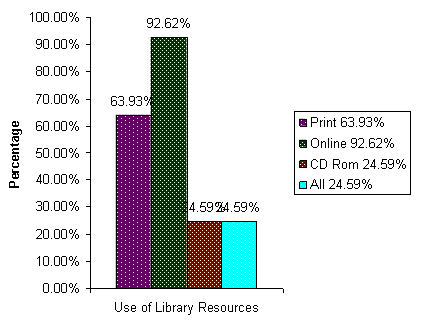 | Figure 1. Perceived level of using the kinds of library resources |
5.3. Links of Online Journals Access
The Respondents were accessing online journals since last decade from different sites e. g. through publishers URLs, through search engine, through the link internet facility’ created on university library home page. And through Jayakar library web portal which created through Jayakar library staff, on 1st august 2008 at the Jayakar library home page. It is beneficial to follow the link of every U.G.C InfoNet publisher wise full text databases for accessing online journals in various areas of subjects. In this regard Respondents were asked to give the response about accessing online journals. The result are summarized in Chart 2 that the large majority of 68.03 Respondents were access online journals through the link ‘internet facility’ created on the university of Pune home page, 56.55 percent responded that they were use search engine for accessing online journals, and only 43.44 percent Respondents were use Jayakar library Web Portal to access online journals and remaining 31.14 percent of the Respondents were accessing online journals through directly from publishers URLs. 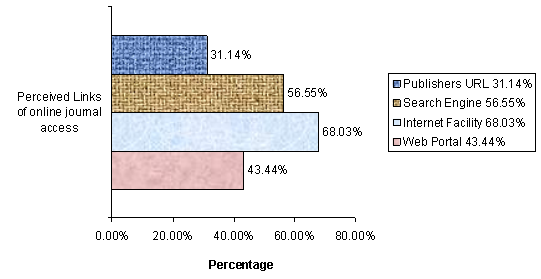 | Figure 2. Links of online journals access |
5.4. Frequency of Library Visit
he Respondents were requested to mark all the modes by which they visit library. Accord ing to their responses, the 39.34 percent Respondents opined that they were visited library once a month, 19.67 percent Respondent were visit library in twice a week as well as more 19.67 percent Respondents were visit library once a fortnight, the ratio of the daily visiting library were just 4.91 percent out of total number of Respondents. 4.09 percent Respondents were visiting library trice a week and 12.29 percent Respondents had not visited to their University library. 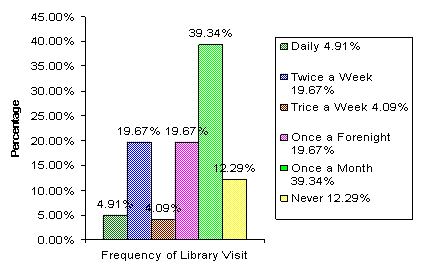 | Figure 3. Frequency of Library Visit |
5.5. Location of Accessing Online Journals
The large majority, 100% of the Respondents indicate that they have access to online journals from their individual department in the University campus while 7.37 percent Respondents opined that they were access online journals from their residence, and there were no response for accessing online journals from university library building out of total numbers of Respondents. 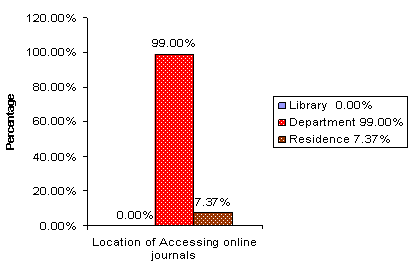 | Figure 4. Location of accessing online journals |
5.6. Perceived Level of Online Journals Search
Respondents were requested to mark the entire mode by which they search the online journals from library Web portal. Generally online journals are search by subject, by title, by Author, and other e.g. by publisher, ISBN no. etc. according to their responses, it was found that the large majority of 77.04 percent Respondents were search online journals by subject 62.92 percent Respondent were search the online journal by title search, 42.62 percent Respondents search their required online journals by authors search and at least 7.37 percent Respondents search their online journals by other type e. g. by publishers name and ISBN no etc. 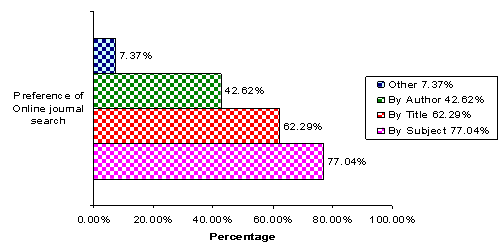 | Figure 5. Perceived level of online journals search |
5.7. Experience of Online Journals Use
Respondents were asked to indicate the number of years of experience they had in using the online journals. It is found that 38.52 percent respondents have been using online journals for last five years, and 26.22 percent Respondents have been using online journals for last ten year, they have ten year experience in using online journals. The chart also depicts that only 13.11 percents Respondents started using online journals since 2 years, and few 21.31 percents Respondents’ have less than a year of experience. Overall, Respondents had good amount of experience to exploit optimally the electronic journals and services.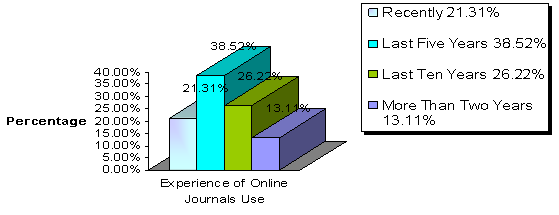 | Figure 6. Experience of online journals use |
5.8. Perceived Modes of Archival Collection for Online Journals Access
The Respondents were asked to indicate the opinion about archival collection of electronic journals provided by university library web portal available in which mode e.g. CD ROM, online, hard copy of bound volumes/ back issue of electronic journals. According to their assessment, the large majority of 95.08% Respondents stated that archival collection of electronic journals available in online mode, 18.03% Respondents stated that the archival collection of online journal available in hard copy of bound volumes or back issue of online journals, and vary few 14.75% Respondents were stated that the archival collection of electronic journal available in both hard copy and online mode, and at least 1.63% Respondents opined that archival collection of online journals available in CD ROM mode. The majority of responses stated that online archival collection is available mostly online than CD ROM and hard copy of back issues. 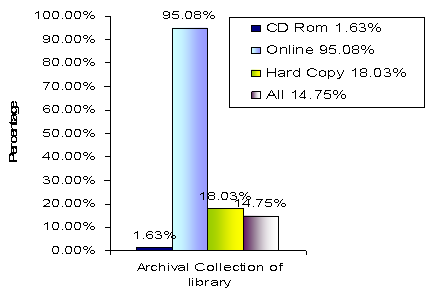 | Figure 7. Perceived modes of archival collection for online journals access |
5.9. Library Alerting Services
The Respondents were asked to indicate their responses about the current issue of the electronic journals because the new issues of online journals always come in the library in the print and the online form, then the faculty member should be aware about the current information, in this regard the Respondents were asked to indicate their responses about the new issue of online journals, it is found that the majority of 48.36 percent Respondents state that they come to know about know journals through email alert service (provided by library staff), 36.06% Respondents indicate that they come to know about New journals through library Web page, and very few 11.47 % Respondents indicate that they come to know about New issue through library user, and at least 9.83% of the Respondents state that they come to know about current issue through library bulletin (Internet) the majority of respondent indicate internet related alert service, those services must be update for better services through the library. 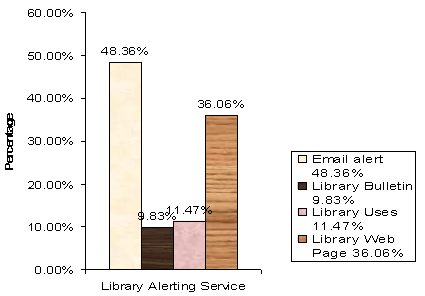 | Figure 8. Library alerting Services |
5.10. Internet Speed
Accessibility of online journals and its use rapidly depend on the internet speed. When internet speed is slow it take more time to accessing, downloading the articles then it is major problem for provision. In this regard Respondents were asked to indicate their opinions about the internet speed in the university campus; According to their assessment it was found that the large majority of 40.16% of the Respondents stated that the internet speed in the university campus was in average, 27.04% of the respondents opined that the speed was slow in University campus, 29.50% of the Respondents marked for the very slow about the speed of internet in university campus. And at least 0.81% responded that the internet speed was fast. Thus it seen that the internet speed is in average the university campus and it is a major problem in accessing online journals. The speed of internet must be increase.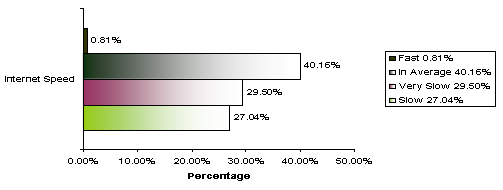 | Figure 9. Internet Speed |
5.11. UGC INFONET E-journal Consortia Provide Full Text and Full Text com
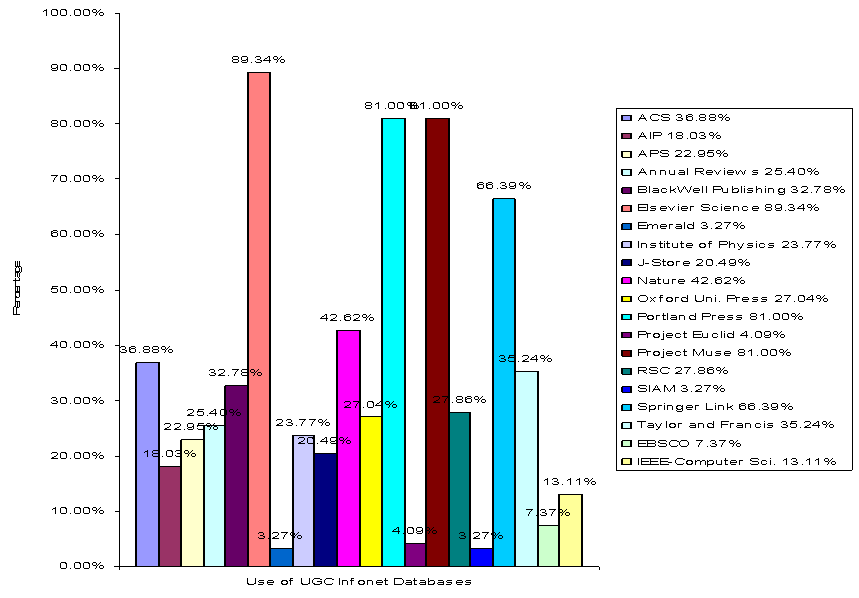 | Figure 10. UGC INFONET E-journal consortia |
Bibliographic databases to provide online journals access to 150 Universities in the country. Respondents were asked to mark about the awareness of UGC INFONET E-journals consortia according to their responses total majority of Respondents were aware about the availability of UGC INFONE E-journal consortia access at the university library and the large majority of 75.40 percent the responded that they could obtain required information from UGC INFONET journals. The percentage of Respondents about the use of publisher wise Full text databases at the Jayakar library web portal university of Pune. According to their assessment it was found that, the large majority of 89.34 percent Respondents were used Elsevier science/science direct publisher wise full text database to access online journals. 66.39 percent responded for Springer link, 42.62 percent of the Respondents indicated for Nature, 36.88 percent and 36.88 percent Respondents marked for the use of American chemical Society, and Back well publishing. 35.24 percent for Oxford University Press, 25.40 percent for Annual Review, 23.77 percent for Institute of Physics, 22.95 percent for American physical society, 20.49 percent marked for Jstor, 18.03 percent for American Institute of Physics13.11 opined for IEEE-Computer Society use, 4.09 percent for Project Euclid, 7.37 percent for EBISCO, 3.27 percent for (SIAM) Society for Industrial and Applied Mathematics, 3.27 percent for Emerald, and at least 0.81 percent and the same 0.81 percent marked for the use of Portland Press and Project Muse at the University Library.
5.12. Use of Bibliographical Databases
Jayakar Library University of Pune Has subscribed some bibliographical databases for accessing online journals and other useful services. Then it must be used in this regard Respondents were asked to indicate their opinion for their assessment of the use of Bibliographical databases. According to their opinions it was found that the majority of 35.24% Respondents marked for the use of Web of Science or Web of Knowledge. 33.60% were use Sci Finder Scholar, 14.75% responded for Royal Society of Chemistry (Six databases) 9.83% marked for the use of MathSciNet, 8.19% responded for the use of JCCC, and very few 1.63% Respondents indicate their opinion for the use of ISDB (Institute for Studies in Industrial Development) this all of this Bibliographical databases are very useful for the science community for their research and teaching. 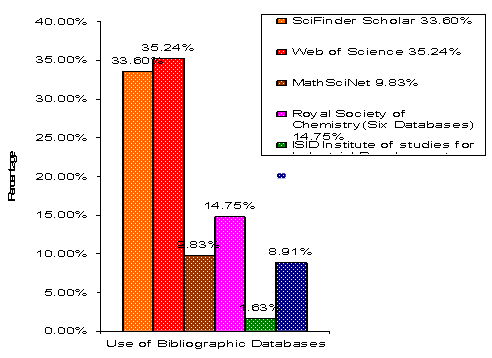 | Figure 11. Use of Bibliographical Databases |
5.13. Open Access Free Directories
Jayakar Library University of Pune provide open access free directory it is open for all Researcher and faculty members, it is also provider online journals. Directory of open access journals (DOAJ), Open J-gate, Free Medical Journals Provides subject wise journals, Respondents asked to indicate their responses about the use of open access free directory, it was found that the 14.75% Respondents were marked for open J-gate, 12.29% Respondents used (DOAG) Directory of open access Journals. And 4.91% of the Respondents opined that they were using Free Medical Journals. 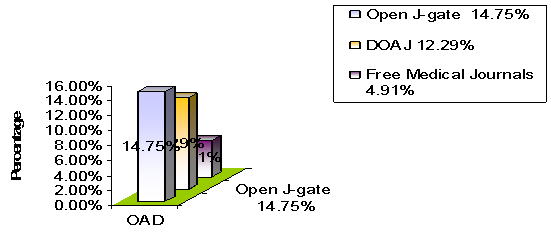 | Figure 12. Open access Free Directories |
5.14. Open Access Journals
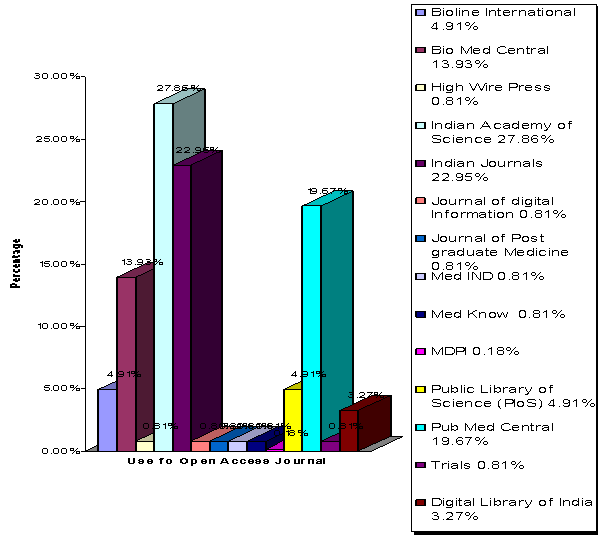 | Figure 13. Open access Journals |
Jayakar Library University of Pune Provide open access journals, these open access journals also provide useful information and online journals. Respondents were asked to mark their opinion about the open access journals According to their assessment of use it was found that the majority of 27.86% respondents were use Indian academy of Science, 13.93% Respondents used Bio Med Central, 4.91% used Bio International, 22.99% of the Respondents used Indian journals, 19.97% Respondents used Pub Med Central, 4.91 of the Respondents were used journal of (PloS) Pubic Library of Science, 3.27% of the Respondents used journals of Digital library of India, and at the least 0.81% Respondents used the journals of Digital information, 0.81% used journal of Post graduate medicine, 0.81% used Med IND, 0.81% of the Respondents were used Med know, 0.81% were used Molecular Diversity Preservation International (MDPI) and 0.81% responded that they used journals of Trials.
5.15. Components Online Journal
Respondents were asked to indicate their opined about the use of online journals components, The options ‘Table of contents, Journals Abstracts, Full text, Article reference, as a online journals Components, with the Modes of use like, ‘Most – A, Often – B, Sometimes – C, Somewhat – D, Least – E, were given to obtain the right perceived level of used online journal components. It was found that the Table of contents used by Respondents in different level, that the majority of 35.24% of the Respondents use mostly table of content, 20.49 responded often use of table of content, 15.57% used sometime (TOC), 3.27% marked for somewhat use of (TOC), and at least 3.37% Respondents use (TOC), Journals Abstracts. The majority of 56.55% Respondents were using Journals Abstracts Mostly, 25.40% Respondents were using journals abstract often. 4.91% of the Respondents use journals abstracts sometime about the use of journal Abstracts, 1.63% Respondents were use somewhat journal abstracts. Full text: Respondents were asked to mark their opinion about the use of Full text online journal component, after the survey it was found that the majority of 52.81% of the Respondents were using full text mostly, 36.06% Respondents responded that they used Full text often. 11.47% responded that they were using sometime full text component of online journals. Article reference: 19.67% Respondents were using the article reference mostly, 33.60% used Article reference often, and 21.31% Respondents were using Article reference sometimes, 5.73% Respondents were using article reference somewhat, and at least 1.63% of the Respondents were using article reference as a component of online journals. The following Chart shows the percentage of Respondents with their use of online journal Components;- 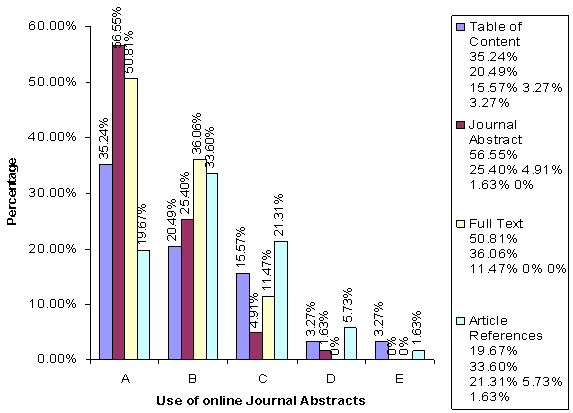 | Figure 14. Components online journal |
5.16. Perceived Level of Using Online Journal Format
Online journals are published in various formats and different format provide different feature for article, thus the user use different format for their use of online journals or other purpose. Respondents were asked to give their opinions about the online journal format. Respondents were using various formats with various mode like most, often, sometime, somewhat, least. (PDF) Portable Document Format Respondents were asked to indicate their opinion about the PDF use, According to their survey it was found that the large majority of 95.90% Respondents marked for the mostly use of PDF, 4.09% Respondents marked for the often use of the PDF, (HTML) Hypertext markup language- 10.65% of the Respondents marked for the mostly use of HTML, 17.21% of the Respondents used HTML often, 18.03% of the Respondents opined for somewhat HTML format. 2.45% of the Respondents were using HTML somewhat, and 7.37% of the Respondents were using HTML at least. SGML-Standard general Markup Language- 3.27% of the Respondents were used SGML sometime, 2.45% of the Respondents marked for the use of SGML somewhat, 15.57% of the Respondents were used SGML format at least. ASCII- 3.27% of the Respondents were marked for the use of ASCII sometime, and the same 3.27% of the Respondents were use ASCII format somewhat, 15.57% opined that they using ASCII format at least. MSWord- 4.91% of the Respondents were use MS-Word mostly, 18.85% of the Respondents were using MS-Word often, 10.65% were using MS-Word sometime, 2.45% responded that they use MS-Word format somewhat, and 9.01% of the Respondents were use online format at least. Postscript- 1.63% of the Respondents were using Postscript Format mostly, 7.35% of the Respondents were use the postscript format often, and 8.19% of the Respondents using the postscript format sometimes for using online journals, 2.45% of the Respondents were using postscript format somewhat, and 13.11% of the Respondents were using postscript format at least.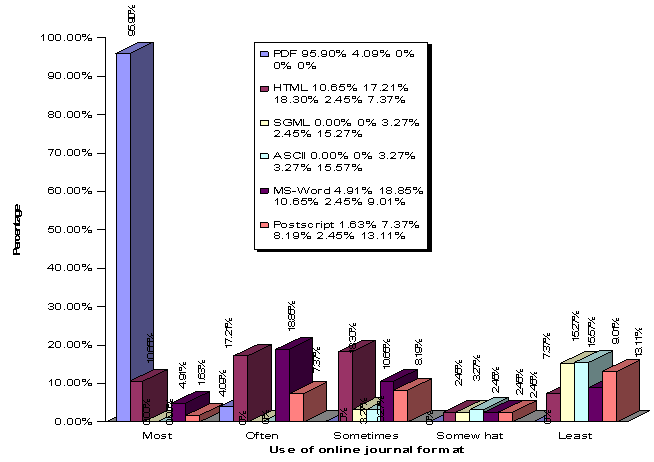 | Figure 15. Perceived Level of using online journal Format |
5.17. Frequencies of Using Online Journals
Respondents were asked how frequently they used online journals. Option were Daily, weekly, Monthly, Biweekly, Bimonthly, the chart show that the large majority of 50.00% of the Respondents were accessing online journals Daily, 22.13% of the Respondents were accessing online journals weekly, 7.37% of the Respondents were accessing online journals monthly.18.03% of the Respondents were accessing online journals biweekly and 2.45% of the Respondents were accessing online journals Bimonthly. 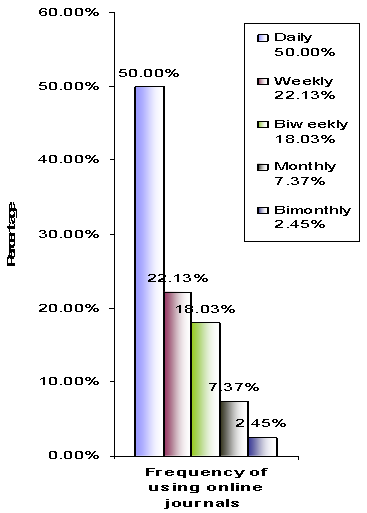 | Figure 16. Frequencies of using online journals |
5.18. Perceived Level of System Speed
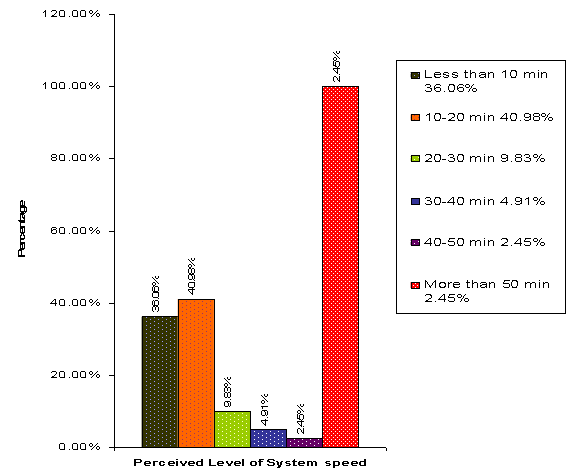 | Figure 17. Perceived level of system speed |
Online journal article taka time to download online articles generally the time of downloading depends on the internet speed Respondents have their different opinion about the downloading time of the online articles with their daily working Networked computer. The Respondents were asked to indicate their opined about the system speed; the options were less than 10 min, 10-20 min, 20-30 min, 30-40 min, 40-50 min, and more than 50 min. According to their responses, it was found that the 36.06% of the Respondents stated that it take less than 10 min, 40.98 percent reported that the system take 10-20 min, 9.83% opined that the system take 20-30 min time to download the online article, 4.91% respondent opined that it take 30-40 min to download one article, 2.45% responded that it take 40-50 min, and 2.45% of the Respondents stated that their networked computer at their Department it take more than 50 minute to download one article. Overall opinions depend on the speed of the Internet, Because of that Internet speed must be improved.
5.19. Time Spent for Reading Online Journals
Respondents were asked about the time which they spent weekly on reading online/off line journals it was found that the large majority of 43.44 percent of the Respondents state that they spent more than 120 min weekly on reading online journals. 4.91 percent spent 90-120 minute for reading online journals, 22.55 percent Respondents spent 60-90 minute, and 9.83 percent of the Respondents spent 30-60minute on reading online journals, 6.55 percent of the Respondents spent up to 30 minute on reading online journals. It was found that 50.81 percent Respondents were spent above 180 minute weekly on off line reading article. 22.95 percent of the respondent spent 120-180 minute weekly on off reading. 4.91 percent of the Respondents state that they were spent 60-120 minute on off line reading. 4.91 percent of the Respondents were reported that they were spent up to 60 minute weekly. 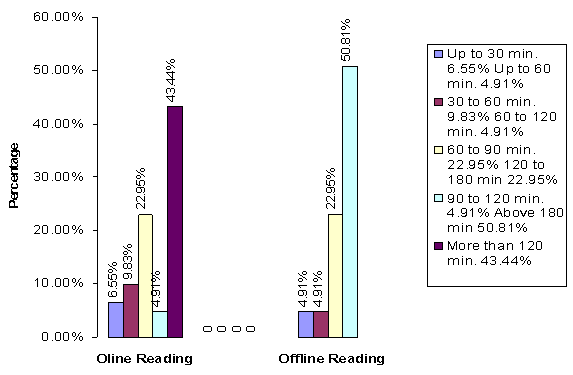 | Figure 18. Time spent for reading online journals |
5.20. Ratio of Reading Online Article
Respondents were asked to mark about the ratio of online article by weekly according to their assessment; it was found that the 13.93 percent of the Respondents read more than 15 articles online in a week. 13.11 percents of Respondents opined that they were read 10-15 articles in a week, 47.75 percent Respondents were read 5-10 articles in a week, and 26.2 percent of the Respondents read less than 5 articles in a week. 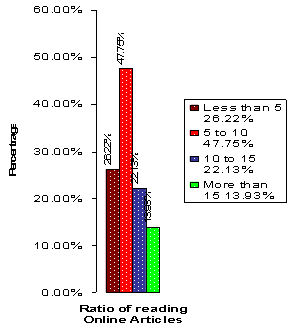 | Figure 19. Ratio of reading online article |
5.21. Perceived Level of Online Reading and on Print Reading
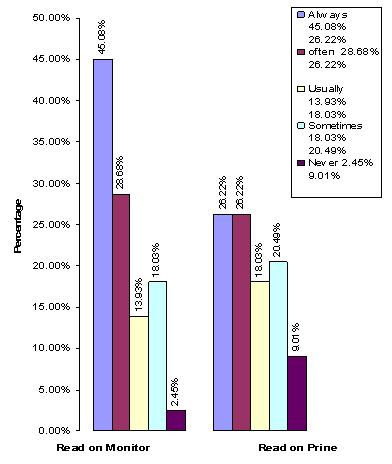 | Figure 20. Perceived level of online reading and on print reading |
Respondents were asked to reported their opinion about the reading online articles, the options were read on monitor and read on print, indifferent mode like always, often, usually, sometime, Never, It was found that the Respondents were preferred to read on the monitor and on print. Read on Monitor: it was found that the large majority of 45.08 Respondents were always read their articles on the monitor, 28.68 percent of the Respondents were often read the journal on the monitors, 13.93 percent responded that they were usually reading articles on the monitor, 18.03 percent of the were read some what their articles on the monitor, 2.45 percent of the Respondents were never read their articles on the monitor. Read on print: it was found that, the large majority of 26.22 percent Respondents were read their articles always on the print, 22.26 percent of the Respondents were read their articles often on the print. 18.03 percent Respondents were read articles usually on the print. 20.49 percent of the Respondents were read their articles sometime on the print, and 9.01 percent of the Respondents were never read the articles on print.
5.22. Online Journals Browsing Features
The Respondents were asked indicate their opinions about online journals browsing features, in this regard several, specific statements were given and agreements and disagreements of the Respondents were recorded. The Chart: 22 shows that the 46.72 percent Respondents were agree strongly with the online journals browsing features, 44.26 percent were agree somewhat, 7.37 percent were disagree somewhat, about the content multimedia information as an online journal browsing feature. It was found that the large majority of 55.73 percent Respondents were Agree strongly, 41.80 percent of the Respondents were agree somewhat, 0.81 percent Respondents were disagree somewhat, and 0.81 percent of the Respondents were disagree strongly about the ‘content easy to understand’ a online journals browsing feature, 68.85 percent Respondents were agree strongly, 30.32 percent Respondents were agree somewhat 0.81 percent of the Respondents were disagree some somewhat, and 0.81 percent of the Respondents were disagree strongly about the ‘user friendly interface’ as a online journal browsing feature, as well as 40.10 percents Respondents were agree strongly, 47.54 percent Respondents were agree somewhat, 9.01 percent Respondents were disagree somewhat and 2.45 percent Respondents were disagree strongly about the ‘reading on monitor’ a online journal browsing feature. Overall statement shows that the online journals were very beneficial for the Respondents. 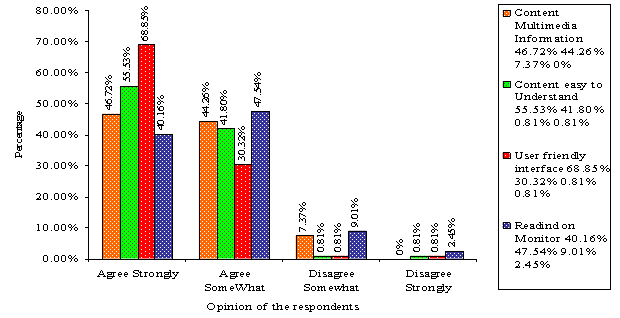 | Figure 21. Online journals browsing features |
5.23. Purpose of Using Online Journals
Respondents were asked to indicate their opinion about the purpose of using online journals, It was found that the large majority of Respondents were using online journals for the for the purpose of research need, majority of 85.24 percent Respondents were using online journals for the purpose of teaching, 79.50 percent of the Respondent were using online journals for the purpose of updating knowledge. 73.77 percent Respondents were using online journal for the purpose of preparing study materials, the most important purpose of the online journals is research reported by the majority of the Respondents.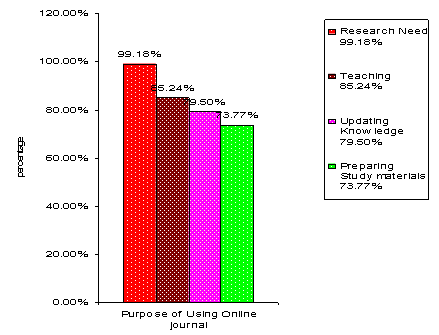 | Figure 22. Purpose of using online journals |
5.24. Regularly Used Search Engines
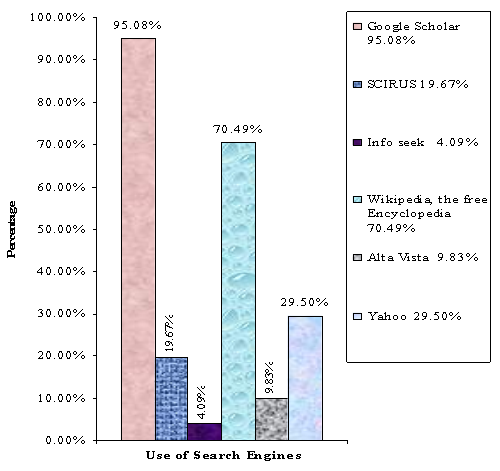 | Figure 23. Regularly used search engines |
The Respondents were requested to provide their opinions about the regularly used search engines. It was found that the majority of 99.18 percent Respondents were using Google 19.67 percent Respondents were using SCIRUS, 4.09 percent were use Info seek, 70.49 percent Respondents use regularly Wikipedia, the free Encyclopedia, 9.83 percent Respondents were using Alta- Vista, 29.50 percent Respondents were use Yahoo search engine. The result is that about regularly using search engine among the Respondents are Google and the Wikipedia, The free Encyclopedia,
5.25. Barriers of Online Journals Use
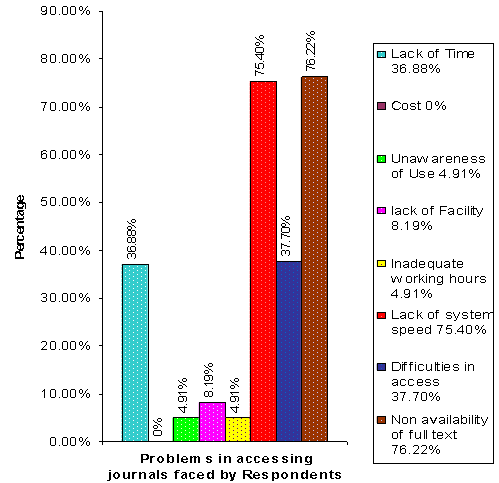 | Figure 24. Barriers of online journals use |
Respondents were asked to indicate their opined about the barriers in using online journals use, the options were lack of time, cost, unawareness of the use, lack of facilities, inadequate working hours, lack of system speed, difficulties, in accessing Non availability of Full text. According to their assessment, it was found that, the majority of 75.40 percent Respondents stated that they were facing lack of system speed, 76.22 percent of the Respondents were stated that they were facing the problem of Non availability off Full text, 37.70 percent Respondents were facing the barrier of difficulties in accessing, 36.88 percent were stated that the lack of time, 8.09 percent Respondents were facing the barrier of lack of facilities, 4.91percent and the 4.91 percent Respondents were facing the difficulty of Unawareness of use and Inadequate working hours, after considering all the problems it is seen that non availability of full text and the lack of system speed, difficulties of accessing and lack of time were the major problem in the use of online journals.
6. Major Findings
1) The majority of science faculty members use online journals for Research, teaching and for updating knowledge. The most important purpose among these is Research purpose.2) The majority of 89.34 percent of the respondent were using science direct journals and the majority of 66.39 percent of the science faculty members responded that they access Springer link journals than other publisher wise full text databases. Thus it can be observed that the most preferred online journals of the science community are Springer journals and journals of science direct full text databases.3) The majority of science faculty members were using Google and Wikipedia, the free Encyclopedia search engines regularly.95.08 percent of the faculty members responded that they were using Google search engine regularly and 70.49 percent responded for the use of Wikipedia, the Free Encyclopedia search engines. The reveals that the most regularly used search engines among the science faculty members were Google and Wikipedia, the free Encyclopedia. 4) The majority of the science faculty members felt that the available online journals in science were moderately adequate.5) The majority of science faculty member spent less than four hours weekly on reading online journals.6) It is observed that the majority of 71.21 percents of the Respondents had not been getting the benefit of the orientation program through library staff to get familiar with the access to online journals.7) It is observed that the majority of 26.22 percent of the Respondents have more than ten year experience and 38.52 percent of the Respondents have more than five years experience as well as 13.11 percents of the Respondents have more than two year experience and 21.31 percents or the Respondents were recently starting to access online journals.8) It was observed that the large majority of 48.36 percents of the Respondents were using E-mail alert services to know the new issue in the library. As well as the large majority of 71.31 percent of the Respondent’s state that the Jayakar library university of Pune provided services are fairly well, it is found that the faculty members opined to provide independent net connection to each faculty members PC not through D-Link. 9) A great majority of the Respondents agreed that they were getting access to more information to and able to save their time considerably in addition to improve their professional competency due to the use of online journals. 10) It is observed that ‘Retrieval of Irrelevant Information’ ‘Poor Connectivity or Slow Access’ and ‘Poor databases searching skill’ are the major problems identified by the Respondents in the use of online journals.11) It was also found that the Non availability of full text, lack of time and lack of system speed were the most important factors that hinder the use of electronic journals among the science stream Pune University campus.
7. Suggestions
The following suggestions are put forward to improve the use of online Journals among the science stream in University of Pune;1) At regular intervals, the University library should organize the orientation training program so that maximum number of user can learn how to use of online journals and other electronic resources.2) In order to eliminate the slow pace of internet connectivity it may be suggested to the to increase Bandwidth and making available computers with latest processors as terminals for online journals and other electronic information sources use.3) More number of computer terminals with electronic information resources accessibility should be instilled and repaired of the non working computers in every department as well as each PC of faculty members should be connected through individually to internet connection not with D-Link to get proper access and save the time of faculty members.4) The emergence of different format of online journals. Necessitate the need of help, supports and explanation of appropriate time, hence the science community of university of Pune may be provide with on-going assistance through compilation, of manual and handbooks in the use of EIS, assistance via e-mail, personal assistance and accessing quality information.5) Also information regarding popular and latest website with their address should be displayed on the notice board on the library web page.6) It is also suggested that university library should subscribe more useful databases e. g. ‘review of scientific information,’ ‘ASP’- American scientific Publishers’ and must be increase the subscription of ‘Web of Knowledge’ and “Biological abstracts, Nature, and ‘RSC’ Royal society of Chemistry and science direct journals according to science community for their pursuit.
8. Conclusions
The emergence of electronic information andcommunication Environment has provide the academic science community of university of Pune. With wide opportunities to satisfy their information needs. The study state that the Jayakar library is switching over to electronic sources to electronic sources at on accelerated pace. Printed sources are supplemented by electronic databases, e-journals, and a variety of other media of communication.
References
| [1] | Baldwin, Christine (1999), Super Journal Project (Available from: http://www.superjournal.ac.uk/sj) |
| [2] | Donnice Cochenour and Tom Moothart (2003), “E-journal Acceptance at Colorado state University: A case study,” Serial Review 29, p. 16-25. |
| [3] | Lad, A. (1995), “User study of Armament Research and Development Establishment (ARDE) library.” Dissertation in M.Lib.I.Sc. University of Pune, Pune, p.10-16. |
| [4] | Dogan Atilgan and Ozlem (Gokkurtr) Bayram (2006), “An evaluation of faculty Use of the Digital Library at Ankara University, Turkey.” Journal of Academic librarianship 32, p. 86-93 |
| [5] | Haughnessy, J., Zechmeister, E., & Jeanne, Z. (2011), Research methods in psychology, New York, NY: McGrawHill, 9 ed., pp. 161-175. |
| [6] | M. Masoom Raza and Askok Kumar Upadhyay (2006), “Usage of E-journals by researchers in Aligarh Muslim University: A study,” The international information and library Review 38, p. 170-79. |
| [7] | Dillon, Irma F. and Hahn, Karla (2002), “Are researchers ready for the electronic-only Journal collection?: results of a survey at the University of Maryland.” Portal: Libraries and the Academy 2(3), p. 375-390. |
| [8] | Blecic, Deborah D.[et al.] (2002), “Snapshot of early adopters of e-journals: challenges to the library.” College and Research Libraries 63(6), p. 515-526. |
| [9] | Zhang, Xiaoyin and Haslam, Michaelyn (2005), “Movement toward a predominantly electronic journal collection.” Library Hi Tech 23(1), p.82-89. |
| [10] | 36. Angle Borrego, Lluis Anglada, Maite Barrios and Nuria Comellas (2007), “Use and Users of Electronic journals at Catalan Universities: the Result of a survey,” Journal of Academic Librarianship 33: 67-75. |
























 Abstract
Abstract Reference
Reference Full-Text PDF
Full-Text PDF Full-text HTML
Full-text HTML